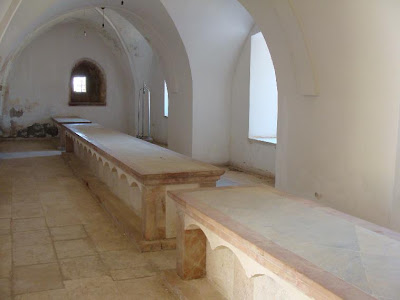Notes on the Feast of the Exaltation of the Cross.










Today both Eastern and Western Christians celebrate the Feast of the Exaltation of the Cross, a celebration of the finding of the remains of the Cross of Christ by St. Helena in 326 as well as the dedication in 335 of a Christian basilica at the place where the cross was found. That basilica, known in the West as the Church of the Holy Sepulchre and in the East as the Church of the Anastasis, remains one of the most venerable pilgrimage sites in Christendom.
For today's feast day, here are some photos I took during a visit to Jerusalem's Monastery of the Cross, built at what tradition regards as the location of the tree that provided the wood of the Cross of Christ. The early history of the Monastery of the Cross is somewhat foggy: one legend holds that the first monastery on this site was established by St. Helena herself, but some scholars suggest that the earliest monastic presence here dates to the 6th century. One way or another, the present structure of the Monastery of the Cross dates to the 11th century, when the King of Georgia sent monks from his country to occupy and restore the cloister. The monastery passed from Georgian to Greek Orthodox hands in the 17th century, and since then it has remained under the control of the Jerusalem Patriarchate.
Visiting the Monastery of the Cross, I was first struck by the incongruity of its surroundings. Located in what was once an isolated valley, thanks to urban sprawl the monastery now sits in a public park surrounded by apartment blocks (first photo). The Greek flag (third photo) and a sign bearing the name of the Jerusalem Patriarchate (fourth photo) offer clues regarding the monastery's inhabitants, who seem to keep a low profile. Though a handful of monks still live at the Monastery of the Cross, much of the complex - including medieval storage rooms (fifth photo) and the old refectory and kitchen (sixth and seventh photos) - is open to the public as a sort of museum. The monastery church (eighth photo) largely retains the appearance it had in Byzantine times, and includes some well-preserved frescoes (ninth photo). The church also includes a much later icon of St. Mary of Egypt (tenth photo), which I photographed for no other reason than that I like Mary of Egypt.
My prayers and good wishes are with all readers on this solemn feast. We bow in worship before your Cross, O Master, and we glorify your Holy Resurrection. AMDG.


1 Comments:
As my Augustinian community prays daily:
We worship you, Lord, we venerate your cross, we praise your resurrection.
Through your cross you brought joy to the world.
Thanks for sharing the photos - and the reflection. I enjoyed the virtual pilgrimage..
Post a Comment
<< Home